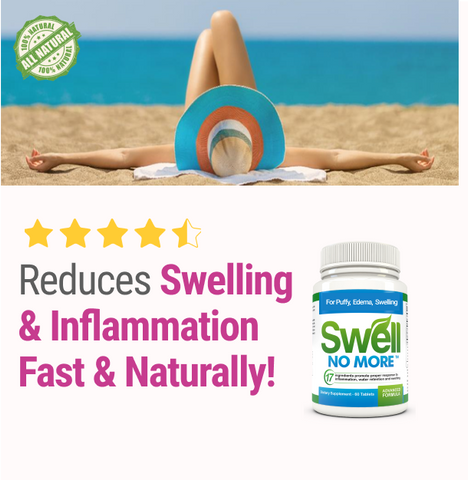How to Reduce Swelling
Swelling is an uncomfortable body reaction that is supposed to help us fight infection, but sometimes it becomes a significant problem and may even lead to death. In this article, you will understand what causes swelling, how to identify it in different areas of the body, and what can you do to reduce swelling through various methods.
What causes swelling?
Swelling is an integral part of inflammation, which is a normal function of the immune system. When immune cells encounter a threat, they start releasing substances called inflammatory cytokines, and they trigger a series of changes in your blood vessels and the affected tissue.
Inflammation makes your blood vessels permeable, and they start to leak water and immune cells to the affected tissue. If the primary threat is not yet destroyed, more immune cells in the tissue lead to more inflammatory substances and more swelling.
In the process, a considerable portion of water leaves the blood vessels and stays in the tissues. That’s the reason why swelling is associated with changes in volume and redness. But even when the inflammatory process stops, it takes time for water to return to the blood vessels. That’s what we call water retention.
People with water retention may not have an active source of inflammation, but their tissues are imbued in liquid. This is often caused by inflammation, low protein levels in the blood, kidney problems, and other ailments.
Types of swelling
Swelling is a broad topic to talk about, and there are both acute and chronic, local or systemic swelling depending on the affected area and the time interval. Two distinct types of swelling we can differentiate are edema and lymphedema:
- Edema: It is the presence of excess liquid in the interstitial space due to water leaking from the blood vessels.
- Lymphedema: Swelling in lymphedema comes from an obstruction on the lymphatic system that results in leaking water to the nearby tissue. It is a common side effect of cancer therapy.
Body parts that swell
Where are you expected to find swelling and how to identify it? These are the most likely areas:
- Ankles: A swollen ankle loses its bony protuberances and looks round and shiny. You might even leave a pit when you press the area with your fingers in some cases.
- Feet: Swelling often starts in the ankle area, but when it is more severe it takes the rest of the foot. Swelling will be clearly visible when comparing one foot to the other, and may also leave a pit after pressing the area.
- Legs: It is commonly detected by looking at the frontal area of your legs, but sometimes it is severe enough to compromise the totality of your lower limbs.
- Hands: Since your hands are full of sensory receptors, edema in this area is often felt like pressure and difficulty to grip your hands.
- Face: Edema in your face is uncommon and often a sign of a severe ailment such as anaphylaxis and preeclampsia unless associated with an injury.
Swelling remedies
There are plenty of pharmaceutical, foods and dietary supplements to improve swelling. Among the top medications to control swelling, we have:
- Diuretic medications: They are intended to flush out excess liquids and usually prescribed to treat swelling caused by liver disease or heart failure.
- Blood thinners: They are prescribed when swelling is associated with a blood clot disturbing the normal drainage of blood.
- Anti-allergy treatment: Used whenever swelling is caused by allergies, such as food allergies and anaphylaxis.
- Anti-inflammatories: They control the inflammation and may reduce swelling, but they are often prescribed to ease up associated pain.
- Natural Herbs that Reduce Swelling : Ginger, Piperine (Black Pepper), Turmeric, Garlic, Juniper Berry, Green tea, Bromelain, Cinnamon, Cardamon and Boswellia Serrata. Look for a natural supplement to reduce swelling that contains all or most of these ingredients like SwellNoMore. Supplements that have natural anti-inflammatory ingredients combined with anti-swelling ingredients are even better, which is why SwellNoMore has both anti-inflammatory and anti-swelling ingredients.
Certain foods also contribute to reducing inflammation and swelling, especially those containing high levels of omega 3 fatty acids such as salmon, olive oil and nuts. However, the best way to reduce swelling through the diet is by avoiding foods that would likely trigger an allergy bout, such as dairy, red meat, and seafood.
If you want an easier way to fight inflammation and swelling, there are also dietary supplements. There are several anti-inflammatory supplements such as turmeric and bromelain, and natural diuretics such as corn silk that would help you swell no more. Our natural supplements reduce edema and swelling while fighting inflammation in a natural and safe way. SwellNoMore is the #1 natural diuretic anti-inflammatory to choose from if you ever suffer from edema, swollen feet, swollen legs, swollen ankles and/or other types of swelling. Visit swellnomore.com to learn more. SwellNoMore Comes With A 60 Day Money Back Guaranty On All Orders.

References:
Antony, S., Kuttan, R., & Kuttan, G. (1999). Immunomodulatory activity of curcumin. Immunological investigations, 28(5-6), 291-303.
de Pascual-Teresa, S., Johnston, K. L., DuPont, M. S., O'leary, K. A., Needs, P. W., Morgan, L. M., ... & Williamson, G. (2004). Quercetin metabolites downregulate cyclooxygenase-2 transcription in human lymphocytes ex vivo but not in vivo. The Journal of nutrition, 134(3), 552-557.
Hasanudin, K., Hashim, P., & Mustafa, S. (2012). Corn silk (Stigma maydis) in healthcare: a phytochemical and pharmacological review. Molecules, 17(8), 9697-9715.
Hall, J. E. (2015). Guyton and Hall textbook of medical physiology. Elsevier Health Sciences.
Klabunde, R. (2011). Cardiovascular physiology concepts. Lippincott Williams & Wilkins.

